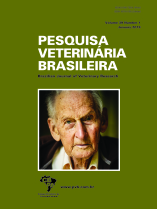 |
|
|
|
Year 2019 - Volume 39, Number 1
|

|
The urban and rural capybaras (Hydrochoerus hydrochaeris) as reservoir of Salmonella in the western Amazon, Brazil, 39(1):66-69
|
ABSTRACT.- Farikoski I.O., Medeiros L.S., Carvalho Y.K., Ashford D.A., Figueiredo E.E.S., Fernandes D.V.G.S., Silva P.J.B. & Ribeiro V.M.F. 2019. The urban and rural capybaras (Hydrochoerus hydrochaeris) as reservoir of Salmonella in the western Amazon, Brazil. Pesquisa Veterinária Brasileira 39(1):66-69. Programa de Pós-Graduação em Sanidade e Produção Animal Sustentável da Amazônia Ocidental, Universidade Federal do Acre, Rodovia BR‑364 Km 4, Distrito Industrial, Rio Branco, AC 69915‑900, Brazil. E-mail: itacir.farikoski@gmail.com
The capybara (Hydrochoerus hydrochaeris) is the largest rodent in the world. In the state of Acre, Brazil, populations of capybaras have been increasing significantly. The role of capybaras in the transmission of certain bacterial zoonotic infections is not well understood, including bacteria of the genus Salmonella. Salmonella spp. generally cause enteritis or septicemia in mammals, however many mammalian species can carry the bacteria asymptomatically and shed it in their feces. To better understand the possible role of capybaras as reservoirs of Salmonella spp., we conducted a study of Salmonella within fecal samples from capybara in Acre. In a convenience sample, 54 capybaras from two urban and two rural areas of Acre were captured and kept for three to four days for sampling. None of the animals were symptomatic of any intestinal illness. Three separate fecal samples were collected from each animal, during their stays in captivity. Each sample was cultured for the presence of Salmonella spp. at the bacteriology laboratory of the Veterinary College of the Federal University of Acre. Samples were seeded in tetrationate pre‑enrichment broth and in pre‑enrichment broth peptone. After a 24 hour of incubation all samples were streaked on MacConkey Agar (MC) and Salmonella‑Shigella Agar (SS). Suggestive colonies were submitted to biochemical analysis. Salmonella compatible colonies according to biochemical profile were submitted to serotyping (Sorokit for Salmonella - Probac do Brasil). In addition, the first sample from each of the 54 capybara was tested for Salmonella spp. using PCR targeting gene hilA. Eight (5%) of the 162 samples examined by bacterial culture were positive for Salmonella spp., while four (7%) of the 54 examined by PCR were positive. From the eight positive animals on culture, five were from urban area and three from rural area. On PCR, only one positive animal was from urban area and four were from rural area. Overall, by either test, one of the 54 animals was positive. All samples were collected in free - living animals with no apparent clinical signs of salmonellosis, indicating the potential of capybara as reservoir on this ecosystem. |
| |
|
|
| |
|
 |